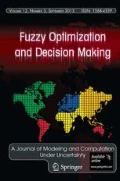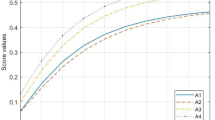Abstract
Linguistic information processing exists in multi-criteria decision making, and linguistic truth-valued lattice implication algebra (LTV-LIA) has definite advantages in handling comparable and incomparable linguistic values. To deal with the preference relations with linguistic evaluation information, we establish a novel approach for solving fuzzy multi-criteria decision problem under linguistic information based on LTV-LIA. In this paper, we propose linguistic lattice-valued preference relation (LLVPR). LLVPR positive and negative matrixes are introduced to evaluate the advantages and disadvantages of alternatives respectively. In order to get a reasonable result, we introduce a new algorithm to check and repair the consistency of a LLVPR. A linguistic lattice-valued 2-tuple representation model (LLV2-tuple) and some new aggregation operations are presented to get the comprehensive linguistic information without information loss. Considering different decision makers have different preferences, a multiple preferences implication operation of LLV2-tuple is introduced. Finally, we propose a novel linguistic analytic hierarchy process embedded in aggregation layer and implication layer, introducing algorithm and numerical examples. A comparative analysis is adopted to illustrate the rationality.



Similar content being viewed by others
References
Cabrerizo, F. J., Morente-Molinera, J. A., Pedrycz, W., Taghavi, A., & Herrera-Viedma, E. (2018). Granulating linguistic information in decision making under consensus and consistency. Expert Systems with Applications, 99, 83–92.
Callejas, E. A., Cerrada, J. A., Cerrada, C., & Cabrerizo, F. J. (2019). Group decision making based on a framework of granular computing for multi-criteria and linguistic contexts. IEEE Access, 7, 54670–54681.
Dong, Y., & Herrera-Viedma, E. (2017). Consistency-driven automatic methodology to set interval numerical scales of 2-tuple linguistic term sets and its use in the linguistic gdm with preference relation. IEEE Transactions on Cybernetics, 45(4), 780–792.
Dong, Y., Hong, W. C., Xu, Y., & Yu, S. (2011). Selecting the individual numerical scale and prioritization method in the analytic hierarchy process: A 2-tuple fuzzy linguistic approach. IEEE Transactions on Fuzzy Systems, 19(1), 13–25.
Dong, Y., Liu, W., Chiclana, F., Kou, G., & Herrera-Viedma, E. (2019). Are incomplete and self-confident preference relations better in multicriteria decision making? A simulation-based investigation. Information Sciences, 492, 40–57.
Dong, Y., Xu, Y., & Yu, S. (2009). Computing the numerical scale of the linguistic term set for the 2-tuple fuzzy linguistic representation model. IEEE Transactions on Fuzzy Systems, 17(6), 1366–1378.
Dong, Y., Zhang, G., Hong, W. C., & Yu, S. (2013). Linguistic computational model based on 2-tuples and intervals. IEEE Transactions on Fuzzy Systems, 21(6), 1006–1018.
Herrera, F., & Martinez, L. (2000). A 2-tuple fuzzy linguistic representation model for computing with words. IEEE Transactions on Fuzzy Systems, 8(6), 746–752.
Li, C. C., Dong, Y., & Herrera, F. (2019). A consensus model for large-scale linguistic group decision making with a feedback recommendation based on clustered personalized individual semantics and opposing consensus groups. IEEE Transactions on Fuzzy Systems, 27(2), 221–233.
Li, C. C., Dong, Y., Herrera, F., Herrera-Viedma, E., & Martłnez, L. (2017). Personalized individual semantics in computing with words for supporting linguistic group decision making. An application on consensus reaching. Information Fusion, 33, 29–40.
Li, C. C., Rodriguez, R. M., Martinez, L., Dong, Y., & Herrera, F. (2018). Personalized individual semantics based on consistency in hesitant linguistic group decision making with comparative linguistic expressions. Knowledge-Based Systems, 145, 156–165.
Liu, P., Cui, H., Luo, S., Diao, H., & Zou, L. (2018). Linguistic-valued lattice-valued 2-tuple representation model. In 2018 5th IEEE international conference on cloud computing and intelligence systems (CCIS) (pp. 620–624). IEEE.
Liu, P., Diao, H., Zou, L., & Deng, A. (2020). Uncertain multi-attribute group decision making based on linguistic-valued intuitionistic fuzzy preference relations. Information Sciences, 508, 293–308.
Liu, W., Dong, Y., Chiclana, F., Cabrerizo, F. J., & Herrera-Viedma, E. (2017). Group decision-making based on heterogeneous preference relations with self-confidence. Fuzzy Optimization and Decision Making, 16(4), 429–447.
Maghsoodi, A. I., Rasoulipanah, H., López, L. M., Liao, H., & Zavadskas, E. K. (2020). Integrating interval-valued multi-granular 2-tuple linguistic bwm-codas approach with target-based attributes: Site selection for a construction project. Computers & Industrial Engineering, 139, 106147.
Martłnez, L., Liu, J., & Xu, Y. (2010). Information fusion and logic-based reasoning approaches for decision making under uncertainty. Journal of Universal Computerence, 16(16), 1–2.
Meng, F., & Chen, X. (2018). A robust additive consistency-based method for decision making with triangular fuzzy reciprocal preference relations. Fuzzy Optimization and Decision Making, 17(1), 49–73.
Meng, F. Y., Tang, J., & Fujita, H. (2019). Consistency-based algorithms for decision-making with interval fuzzy preference relations. IEEE Transactions on Fuzzy Systems, 27(10), 2052–2066.
Tang, J., Meng, F., Cabrerizo, F. J., & Herrera-Viedma, E. (2019). A procedure for group decision making with interval-valued intuitionistic linguistic fuzzy preference relations. Fuzzy Optimization and Decision Making, 18(4), 493–527.
Xu, Y., Liu, J., Martłnez, L., & Ruan, D. (2010). Some views on information fusion and logic based approaches in decision making under uncertainty. Journal of Universal Computerence, 16(1), 3–19.
Xu, Y., Ruan, D., Qin, K., & Liu, J. (2003). Lattice-valued logic. In Studies in fuzziness and soft computing (Vol. 132).
Xu, Z., & Liao, H. (2014). Intuitionistic fuzzy analytic hierarchy process. IEEE Transactions on Fuzzy Systems, 22(4), 749–761.
Xu, Z., & Zhou, W. (2017). Consensus building with a group of decision makers under the hesitant probabilistic fuzzy environment. Fuzzy Optimization and Decision Making, 16(4), 481–503.
Zhang, Z., & Pedrycz, W. (2018). Goal programming approaches to managing consistency and consensus for intuitionistic multiplicative preference relations in group decision making. IEEE Transactions on Fuzzy Systems, 26(6), 3261–3275.
Zou, L., Liu, X., Ruan, D., & Xu, Y. (2012). Linguistic truth-valued intuitionistic fuzzy algebra. Journal of Multiple Valued Logic & Soft Computing, 18(5–6), 445–456.
Acknowledgements
This work is partially supported by the National Natural Science Foundation of P.R. China (Nos. 61502068, 61772250) and the Scientific Research Project of Department of Education of Liaoning Province (No. LJ2020007).
Author information
Authors and Affiliations
Corresponding authors
Ethics declarations
Conflict of interest
The authors declare that they have no conflict of interest.
Additional information
Publisher's Note
Springer Nature remains neutral with regard to jurisdictional claims in published maps and institutional affiliations.
Appendix
Appendix
In this appendix, detailed calculation process of numerical examples is introduced.
Determine the LLVPR according to the linguistic fundamental scale by pair-wise comparisons respectively.
Compute the LLVPR positive matrix and negative matrix of every preference relation matrix.
Aggregate every row of every matrix and calculate the comprehensive aggregate value. We take the \({G_{LAAO}}\) as an example.
According to the above calculation, the criterion aggregation value and alternative aggregation value can be obtained as follows
Rights and permissions
About this article
Cite this article
Diao, H., Deng, A., Cui, H. et al. An approach for solving fuzzy multi-criteria decision problem under linguistic information. Fuzzy Optim Decis Making 21, 45–69 (2022). https://doi.org/10.1007/s10700-021-09356-x
Accepted:
Published:
Issue Date:
DOI: https://doi.org/10.1007/s10700-021-09356-x




